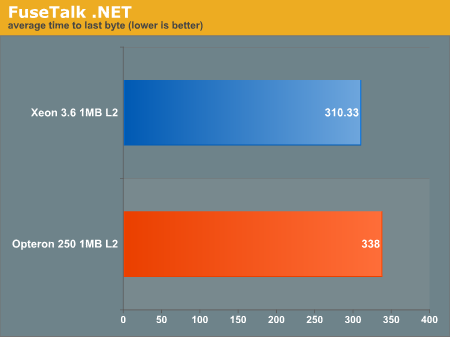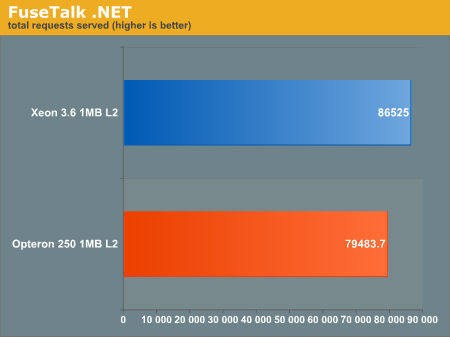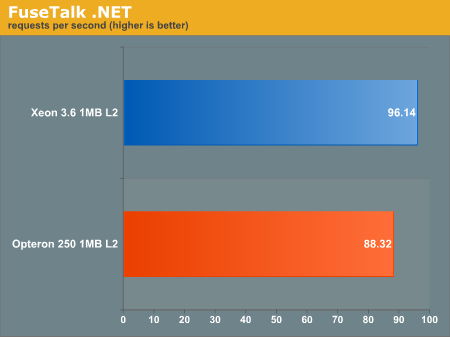Intel and AMD in a Web Application Shoot-out
by Jason Clark on October 18, 2004 12:05 AM EST- Posted in
- IT Computing
Microsoft .NET
This was probably the most interesting test out of the bunch, as there was a recognizable difference in the two architectures. Our .NET test was run on the recently released FuseTalk .NET collaboration application.The .NET platform is the new framework for building Windows-based and web-based applications from Microsoft. It not only replaces the older ASP platform, but introduces some up-to-date languages that run on the Common Language Runtime, which is the backbone of .NET. The three main languages used with .NET are: C# (similar to C++), VB.NET (somewhat similar to VB), and J# (fairly close to JAVA). Whatever language in which you write your code, it is compiled into an intermediate language, CIL (Common Intermediate Language). It is then managed and executed by the CLR (Common Language Runtime).
As you can see from the test results below, the Xeon managed to take the lead by approximately 8%. Why? Well, the one interesting piece of information that the .NET JIT (Just in Time) compiler takes into account during the compilation to native code is CPU architecture. According to a Microsoft MSDN article published by Allan McNaughton from Intel, the .NET JIT compiler takes CPU architecture into account during the last phase of compilation to native code. Specifically, during compilation, the JIT will detect Intel processors and produce code that takes advantage of Intel NetBurstTM and Hyper-Threading technology. With version 1.1 of the JIT compiler, Intel's Streaming SIMD Extensions 2 can also be a factor. At the time of publication, no information regarding any performance enhancing optimizations that occur for the AMD Opteron were found.













48 Comments
View All Comments
Beenthere - Monday, October 18, 2004 - link
Why would you use a 40 GB 7200RPM 8MB Cache IDE Drive for a performance server??? Wouldn't you use a faster/larger drive or dual drives???tyski34 - Monday, October 18, 2004 - link
#4"The difference between the Opteron and Xeon here was approximately 3%, which isn't far off our deviation of 2.5%."
= a draw statistically
gherald - Monday, October 18, 2004 - link
Why yes #4, it is clear that the Opterons bested the Xeons in the ColdFusion and PHP tests by a slim margin. But tech writers call such things draws, since such small percentage points in performance are fairly negligeable.Boonesmi - Monday, October 18, 2004 - link
"The results throughout much of these tests were a draw, right up until the Microsoft .NET tests"huh? the opteron was fastest in every benchmark except the .NET tests.... a draw would have been if each platform has won some and lost some.
bozilla - Monday, October 18, 2004 - link
If someone would read this from anandtech and do a test between these 2 configuration for content creation and test these computers as workstations, with the design/video/3d applications. What I'm asking for I guess is comparison between the best AMD has to offer against the latest Intel offering. I think this is only fair, since as we all know these workstation can cost as low as $4k (if self-built) as oppose to single CPU machines from Falcon Northwest or Alienware that cost pretty much the same. I think that many people like me who are in creative profession would like to see who is the performance king in dual system for this field. Maybe you should definitely include gaming tests and compare these dual machines with single CPU machines (FX53, P4EE, P4 560)Thanks.
Ardan - Monday, October 18, 2004 - link
LOL thats a good summary :)Denial - Monday, October 18, 2004 - link
To save everyone the 2 minutes it takes to read this...For the 32 bit apps which were tested, the difference is negligible.
Move along now.
Mathan kb02 - Wednesday, August 19, 2020 - link
Great post about web app